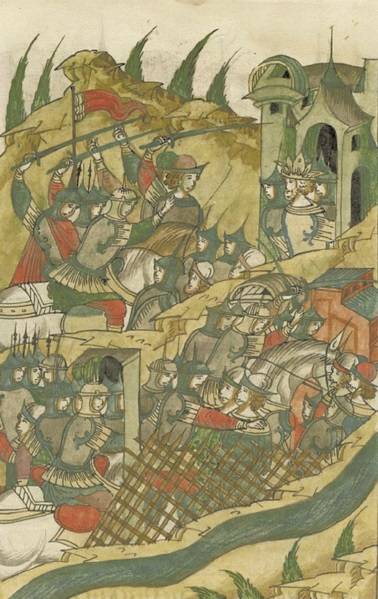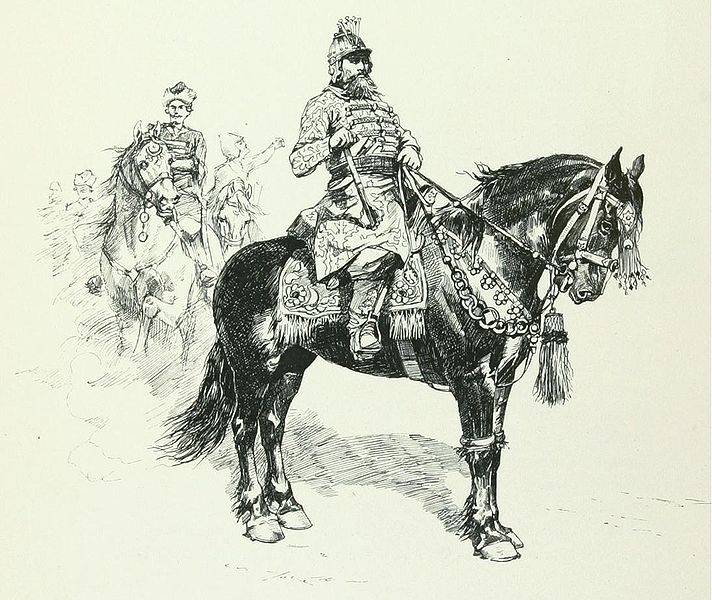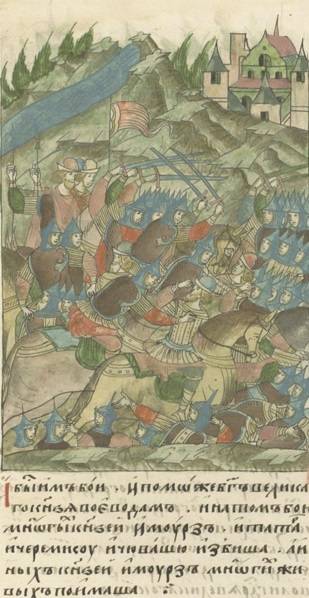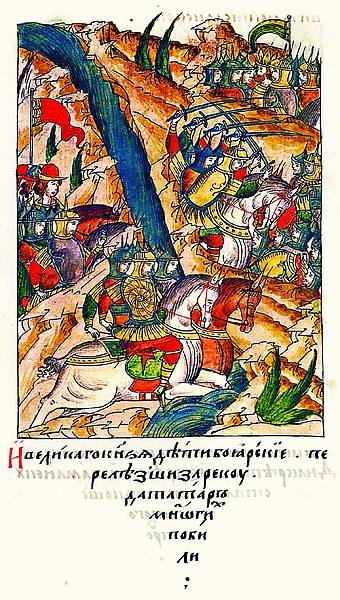Battle on the Volga. The fight between Moscow and Kazan

The capture of the Tatar prison by the Russians near Kazan. Miniature of the Observational Codex. 1530 year
Death of Mehmed-Girey
After the simultaneous invasion of the Crimean and Kazan hordes in 1521 (Crimean tornado) Sovereign Vasily Ivanovich came to the conclusion that it was impossible to continue the war on several fronts. He invited the Polish king Sigismund to resume negotiations. At this time, the Grand Duchy of Lithuania was at war with the Livonian Order. Lithuania's state after 9 years of war with Moscow was deplorable. In the south, Crimeans constantly raided, so Sigismund agreed. In September 1522, an armistice was signed in Moscow for 5 years. Smolensk remained with Moscow, and Kiev, Polotsk and Vitebsk - with Lithuania.
The freed regiments were set up by Moscow against the Crimea and Kazan. The Crimean Khan Mehmed-Girey, after the success of 1521, became proud. Under his control were the Crimean and Kazan Khanates, the Nogai Horde. The Crimean tsar planned to restore the Big Horde, to subjugate Astrakhan. In the spring of 1523, the Crimean troops, together with the legs, captured Astrakhan. In the place of the Astrakhan Khan, the eldest son of Mehmed-Girey, Bahadir-Girey, was planted. The three khanates united. It seemed that the Golden Horde was reborn! Sahib-Girey in Kazan, learning about this news, ordered the execution of the captive Russian ambassador Podzhogin and all Russian merchants. I decided that with such power, Moscow is no longer dangerous. This act caused great irritation in Russia.
However, the celebration was very short. Nogai murzas - Mamai, Agish and Urak, fearing an increase in the power of the Crimean Khan, decided to kill him. Meanwhile, Mehmed-Girey did not see the threat and disbanded his troops, remained in Astrakhan with a small guard. The Nogai lured him out of the city and killed him along with his son, the Astrakhan khan. After that, the Nogais struck a sudden blow at the Crimean camps, where they did not expect an attack. The rout was complete. The Nogays devastated the Crimean peninsula, only the cities survived. The new Crimean Khan Gazi-Girey was no longer up to the plans for the revival of the Golden Horde and the war with Moscow. In addition, the Porta did not approve of Gazi's candidacy, he was quickly replaced by Saadet-Girey (Gazi's uncle), who was sent from Istanbul with a detachment of janissaries. Gazi was killed. Saadet had to face the discontent of a part of the Crimean nobility, to fight with his nephew Islam-Giray.
Hike 1523 of the Year
The Russian sovereign did not fail to take advantage of the turmoil in the Crimean Khanate and sent his regiments to Kazan. In August 1523, a large army was gathered in Nizhny Novgorod. Vasily Ivanovich himself arrived there. The advance detachment was led by Shah Ali. The troops were divided into ship and horse troops. The ship's army was headed by the voivods Vasily Nemoy Shuisky and Mikhail Zakharyin-Yuriev, the equestrian army - by the voivods Ivan Gorbaty and Ivan Telepnev-Obolensky.
In September 1523, Russian regiments crossed the border river Sura. The ship's army, together with Shah-Ali, walked to the outskirts of Kazan, ravaging villages on both banks of the Volga. Then she turned back. Horsemen reached the Sviyaga River, defeated the enemy on the Ityakov field. The Russians laid the Vasil-city in honor of the sovereign Vasily on the right, Kazan bank of the Sura, at the place where it flows into the Volga (Vasilsursk). It is possible that earlier on this place there was already a settlement of the Mari tribes. The Russians swore in the local residents - the Mari, Mordovians and Chuvashes. The fortress became an outpost for observing the enemy and a base for strikes against Kazan. A strong garrison was left in the city.
After the withdrawal of the Russian troops in October 1523, the Kazan Khan Sahib-Girey undertook a large retaliatory raid. His goal was the frontier Galician land. Tatars and Mari (earlier they were called Cheremis) laid siege to Galich. After an unsuccessful assault, they left, devastating the surrounding villages and taking away many prisoners. Kazan Khan was now afraid of Moscow. He asked for help from Saadet-Giray. He asked to send cannons, and the janissaries were also sent to Kazan. However, Crimea was plunged into turmoil and could not support Kazan. Then Sahib-Girey sent ambassadors to Istanbul. He announced that he was giving the khanate to the sultan.
Suleiman was an intelligent ruler. He had many other priority tasks, not up to Kazan. But if there was an opportunity to purchase something, why refuse? In addition, the Gireys were his relatives. The Kazan Khanate became a vassal of the Port. Turkish ambassadors announced this in Moscow. But they were told that Kazan had long recognized its dependence on the Russian sovereigns and that the Sahib had no right to give it to anyone. Suleiman did not insist. He did not send troops to distant Kazan. But he did not refuse to accept citizenship either.

Grand Duke Vasily III Ioannovich. Source: Grand Duke and Tsarist Hunt in Russia, Volume 1, 1896
Hike 1524 of the Year
In the spring of 1524, Grand Duke Vasily Ivanovich organized a new large campaign against Kazan. Formally, the former Kazan Khan Shah-Ali was at the head of the army. In fact, the regiments were led by the governors Ivan Belsky, Mikhail Gorbaty-Shuisky and Mikhail Zakharyin-Yuriev. Separately, the ship's army acted under the command of governors Ivan Khabar Simsky and Mikhail Vorontsov. On May 8, the ship's army set out, on May 15, the horse army.
The situation was favorable. A large Polish-Lithuanian army invaded the Crimean Khanate. The Crimean king Saadet-Girey was gathering troops to strike at Lithuania. In June, the Crimean horde invaded the Lithuanian lands. The trip ended unsuccessfully. On the way back, the Crimeans were patted by the Cossacks.
Sahib-Girey, not receiving help from the Crimea and Turkey and fearing a large Russian army, fled from Kazan to the Crimea. He left his 13-year-old nephew Safu in his place. Kazantsev was outraged. They said that they did not want to know such a khan. The Kazan nobility, headed by Shirin, elevated Safu-Giray to the throne.
In early July, the Russian ship's army landed the regiments of Belsky, Gorbaty-Shuisky and Zakharyin near Kazan. The Russians fortified themselves and waited for the arrival of the cavalry. Kazan Tatars made a series of attacks on the Russian army, trying to defeat or drive them out before the arrival of reinforcements. The Kazanians were repulsed, but continued to block the fortified camp. Soon the Russians began to run out of food. The second ship's army under the command of Prince Ivan Paletsky came to the rescue from Nizhny. She was ambushed by the Cheremis. The cavalry regiment, which accompanied the ships by land, was defeated. Then at night the Mari attacked the ship's army. Many soldiers were killed or taken prisoner. Only part of the ships broke through to Kazan. The equestrian army soon arrived. On the way, the warriors of Khabar and Vorontsov defeated the Kazan cavalry in the battle on the Ityakov field. As noted in the annals:
In mid-August, Russian troops began a siege of Kazan. However, no success was achieved. Obviously, the organization of the trip was bad. Tatar and Mari detachments continued to operate in the rear of the Russian army. Russian regiments had to fight on two fronts. However, the negotiations were also beneficial for the Kazan nobility. Russian artillery was crushing the walls, the situation was becoming dangerous.
Negotiations began. The Russian governors lifted the siege in exchange for the Kazan residents' promise to send an embassy to Moscow to conclude peace. There were rumors that the governors, led by Belsky, received rich gifts so that the Russians would return home. The Russian regiments lifted the siege and left.
In November, the Kazan embassy arrived in Moscow. After the Russians left the Kazan Khanate, the Nogai invaded and ravaged the southern borders, so the Kazan nobility was interested in restoring peace with Moscow. Peace has been restored.
To avoid a new massacre of Russians in Kazan, the Russian government achieved the transfer of the annual fair from Kazan to Nizhny (the future Makaryevskaya fair). In 1525 the fair was opened in Nizhny Novgorod. The trade turnover of the main Volga fair due to the riots in Astrakhan, the war between Moscow and Kazan fell significantly. This greatly affected the profits of Russian and Eastern merchants, but the Kazan Khanate, which was rich in transit Volga trade, suffered the greatest damage.

Victory of the Russian army over the Kazan Tatars. 1524 year
Southern frontier
Relations between the Russian state and Crimea remained tense. But the khan could not organize large campaigns against Muscovite Rus due to internal strife. Rod Gireyev fought for power.
In 1525, Saadet-Girey moved with a large army to the Moscow borders, but after Perekop he learned about the uprising of Islam-Girey. He had to stop the campaign and go back to fight with his nephew. Is the same story repeated in 1526. The forces were approximately equal. Therefore, Saadet and Islam were temporarily reconciled. Saadet retained the throne and appointed Islam kalga (the second most important person in the hierarchy of the khanate). Islam-Girey received Ochakov as his inheritance.
Moscow tried to use the allotted time and continued to strengthen the southern borders. Stone kremlins are being built in Kolomna and Zaraisk. In the fall of 1527, Tsarevich Islam-Girey moved his troops to Russia. Moscow was informed in time of the enemy campaign and that the Crimeans were planning to force the Oka near Rostislavl. This time the Russian governors did not fail and closed the border near Rostislavl. The Grand Duke himself with a reserve army stood in the village of Kolomenskoye, then also set out to the Oka.
In case of a blow from the Kazan horde, the eastern border was also reliably covered. Reinforced garrisons were stationed in Murom, Nizhny Novgorod, Kostroma and Chukhloma. The population living in the vicinity of cities located on the path of a possible invasion of the horde was gathered in the fortresses. The defense of Moscow was hastily strengthened.
On September 9, the Crimeans went to the Oka and tried to force it. However, the Russian regiments repulsed all attempts to "climb" the river. Many Tatars drowned in the Oka. Islam has turned back. Following were sent the cavalry regiments, which overtook the enemy at Zaraisk. In the battle on the Sturgeon River, the Crimeans were defeated. In October, the troops of Islam-Girey, pursued by the Russians and demoralized by failure, fled across the Don. In Moscow, Tsar Vasily Ivanovich ordered to drown Ambassador Saadet.
In 1528, Islam again opposed Saadet. He was defeated and fled to the possession of the Polish king Sigismund. The Crimean prince made an alliance with Sigismund. In 1529 Islam marched at Perekop. Saadet-Girey, who was afraid of the transition of most of the Crimean Murzas to the side of his nephew, offered peace. The relatives reconciled again on the same terms. In 1531 Islam revolted again against his uncle. Saadet, tired of the constant conspiracies of the nobility and revolts, in 1532 renounced the throne and departed for Constantinople. The Khan's table was occupied by Islam. But soon Sahib-Girey arrived from Istanbul, all the major Crimean feudal lords obeyed him. Islam received the post of kalgi, he was given Ochakov and Perekop.
The Russian government used the experience of the 1527 campaign in the following. The regiments were stationed in Kolomna, Kashira, Serpukhov, Ryazan, Tula, in dangerous directions. At the moment of the threat, they were strengthened. In 1530-1531. new wooden fortresses were erected in Chernigov and Kashira, the construction of a stone Kremlin in Kolomna was completed. Having created a powerful defense in the southern direction, Vasily III again tried to resolve the Kazan issue.

The defeat of Islam-Girey by the Russian troops on the Oka in 1527. Miniature of the Observational Codex
Russian-Kazan war 1530-1531
In the spring of 1530, the Russian ambassador Andrei Pilyemov, who arrived in Kazan, was committed "evil spirits and shame". The chronicle does not provide details. This served as a pretext for a new war. Moscow decided that it was time to return Kazan under its control. Having reliably covered the southern border, Tsar Vasily in May 1530 moved his troops to Kazan. He acted according to the old scenario. The troops were divided into two ratios - ship and horse. The ship's army was led by the governors Ivan Belsky and Mikhail Gorbaty, the equestrian army was led by Mikhail Glinsky and Vasily Sheremetev.
Obviously, the insult to the ambassador was a planned action. Kazan residents are well prepared for the war. The Nogai army of Mamai and the Astrakhan detachments of Prince Yaglych arrived to the aid of Kazan. A prison was erected near Kazan on the Bulak River in order to complicate the siege of the capital.
The ship's men arrived at Kazan without any problems. The cavalry regiments, defeating several enemy detachments on the way, also successfully crossed the Volga and on July 10 joined the ship's army. On the night of July 14, the regiment of Ivan Ovchina-Obolensky stormed the prison on the river. Bulak. Most of his garrison was killed. The first setbacks and the artillery shelling that began alarmed the townspeople. Many began to demand an end to the struggle and the beginning of negotiations with the Russians. In such a situation, Safa-Girey fled from the city to Astrakhan.
However, the Russian commanders did not use the favorable moment for the attack. They started a parochial dispute over who would be the first to enter Kazan. A storm suddenly broke out. The Kazanians staged a surprise sortie and threw back the Russian troops. The Tatars captured part of the artillery of the Russian army - 70 squeaky guns and mobile fortifications (gulyai-gorod). The Russian regiments who came to their senses resumed the siege, but without success. On July 30, the siege was lifted, the Moscow regiments went beyond the Volga. The chief governor Ivan Belsky was found guilty of the failure. He was sentenced to death, but then imprisoned, in which he remained until the death of Vasily Ivanovich.
The Tatar nobility, despite the victory, understood that the Russians would come with renewed vigor and it would be worse. Even before the return of Safa-Girey to Moscow, a Kazan embassy was sent, headed by princes Tabai and Tevekel. On behalf of Safa-Girey, they made a vassal oath to Vasily III. The ambassadors promised that the oath would be confirmed by the khan, all Kazan princes and murzas. The Russian ambassador Ivan Polev was sent to Kazan to swear in the khanate. Also, the Kazan residents were supposed to hand over the prisoners and the captured "outfit" (artillery).
However, Safa-Girey, who returned to Kazan, refused to obey Moscow. Negotiations have resumed. Safa was dragging out time and making new demands. At the same time, his ambassadors asked for help from the Crimea. Saadet could not provide effective assistance to his nephew, but the situation in the southern direction worsened. The Crimeans raided the Odoy and Tula places.
Meanwhile, Moscow diplomats were able to win over the Tatar ambassadors Tabai and Tevekel. Through them, contacts were established with the Kazan nobility, with the influential princes Kichi-Ali and Bulat Shirin. They were also supported by Queen Kovgarshad, the sister of Khan Muhammad-Amin. The Kazan feudal lords were dissatisfied with the policy of Safa-Girey, who ruined the khanate with continuous wars with the Russians. The fact that the khan surrounded himself with Crimean and Nogai advisers. In addition, Safa-Girey decided to execute the entire Russian embassy. This was fraught with a new bloody war with Moscow. The khan could have escaped, but the Kazan people had to lay down their heads and lose their property.
As a result, the Kazan nobility in 1531 opposed the khan. Crimeans and Nogais were killed or expelled. Safa-Girey fled to the Crimea. The Moscow government wanted to put Khan Shah-Ali on the Kazan table. However, the Kazan elite resisted. Shah-Ali was not loved in Kazan. The khans asked for the younger brother of Shah-Ali, the Kasimov prince Jan-Ali.
Thus, peace and union were restored between Moscow and Kazan, which remained until the death of Tsar Vasily Ivanovich in 1533.
Information